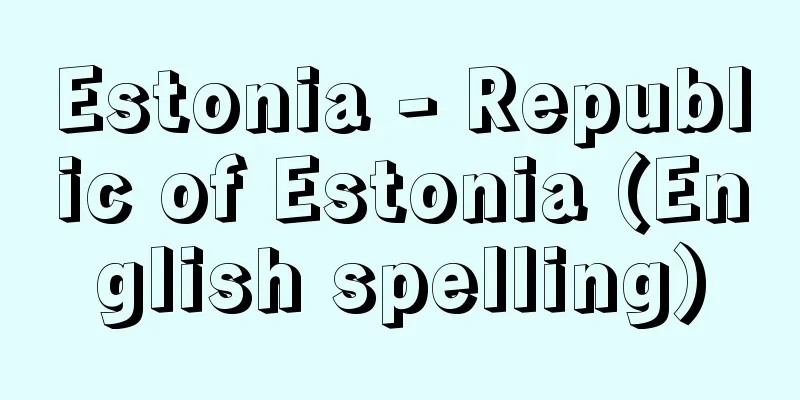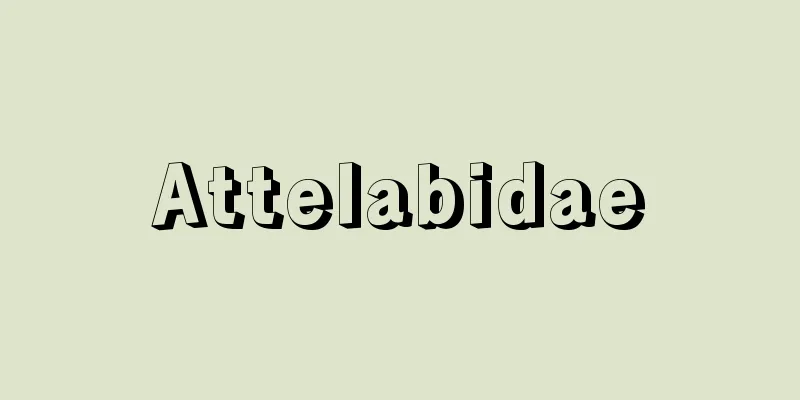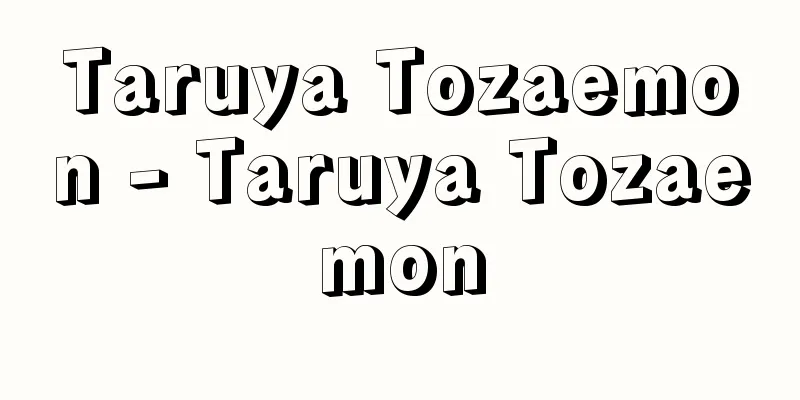Estonia - Republic of Estonia (English spelling)

|
A republic located in northeastern Europe. After gaining independence in 1918, it was annexed by the Soviet Union in 1940 and became one of the socialist republics that made up the federation, but regained independence in 1991 and became the Republic of Estonia. In September of the same year, it joined the United Nations. It is one of the so-called Baltic states, along with Latvia and Lithuania. The country faces the Baltic Sea to the north and west (coastline 3,794 km), the Russian Federation to the east (border 294 km), and the Republic of Latvia to the south (border 339 km). The area is 45,227 square km, and the total population is 1,370,052 (2000 census), 1,294,455 (2011 census). The capital is Tallinn. Other major cities include Tartu, Narva, Kovtla-Järve, and Pärnu. It is a multi-ethnic country, with the population composition by ethnicity being 68.5% Estonian, 25.7% Russian, 2.1% Ukrainian, 1.2% Belarusian, 0.8% Finnish, and 1.7% other (2005). The official language is Estonian, which belongs to the Finno-Ugric branch of the Uralic language family and is a Baltic-Finnic language. During the Soviet era, Russian was the first official language, and immigration from Russia was encouraged, so many residents use Russian on a daily basis. As for religion, the majority are Lutherans (152,000 people) and Estonian Orthodox (144,000 people), with other religions including Baptists and Catholics (2000). [Ryo Imamura] NatureLocated in the northwest of the East European Plain, the country is generally flat, with the highest point, Mt. Munamagi, at 318 meters, and the average elevation at about 50 meters, although the elevation increases slightly in the eastern and southeastern parts of the country. There are about 420 rivers over 10 kilometers long, the main ones being the Narva River, which forms the border with the Russian Federation and flows into the Gulf of Finland, the Emayoghi River, which flows into Lake Peipus (Russian name: Lake Chud), and the Pärnu River, which flows into the Gulf of Riga. There are more than 1,400 lakes and marshes, including artificial lakes such as Lake Peipus, which forms the border with the Russian Federation, and about 12,000 mud marshes and wetlands with a total area of about 9,000 square kilometers. The vegetation is relatively rich, with forests covering more than 40% of the country's land area, including planted areas, and the primary forests are dominated by conifers. The climate is mild, albeit somewhat cold, with an average annual temperature of 6.0°C in the westernmost part of the country and 4.2°C to 4.5°C in the easternmost part. The average monthly temperature is a minimum of -6°C in February and a maximum of 17°C in July. The average annual precipitation is about 700 mm, with snowfall occurring from December in the southeastern part of the country and from January to March in other areas. [Ryo Imamura] historyEstonians of Baltic-Finnish descent lived in the northern Baltic coast around 500 BC, and formed several tribal groups in the 10th century. The Livonian Order, which replaced the German Sword-bearing Knights, who began colonizing the southeastern coast of the Baltic Sea from the end of the 12th century, took possession of what is now southern Estonia and northern Latvia. Northern Estonia was conquered by the Danes in 1219, and sold to the Livonian Order in 1346. The name of the current capital, Tallinn (meaning Taani linn, the town of the Danes), still bears traces of this. Thus, the ruling class was German, and the ruled class was Estonian. Tallinn later developed as a Hanseatic city. The feudal rule by Germans, backed by the power of the church, lost its meaning with the Protestant Reformation in the mid-16th century. Due to the weakening of the Livonian Order and the resulting struggle for supremacy between Sweden and Russia, the territory of the Livonian Order was dissolved in 1561, Tallinn and northern Estonia became Swedish territory after 1561, and northwestern Livonia, including Riga, also came under Swedish control in 1629. In most of present-day Estonia, which became Swedish territory, feudal rule by German landowning aristocrats continued. This period was later called the "good old Swedish era", with the University of Tartu being founded in 1632, but in reality the burden on peasants increased. Russia's westward expansion towards the Baltic Sea was again indicated by the Great Northern War that began in 1700, and the Treaty of Nystad in 1721 saw the region pass from Sweden to Russian control. During this time, the urban population was still small and peasants were educated at home, but the literacy rate was high. The movement of the Pietist Moravian Brethren had spread to Estonians by around 1730. The Enlightenment also influenced Baltic German landowners. Furthermore, influenced by Romanticism, Estonians began to collect folk songs and epic poems. The University of Tartu, which had been closed in 1710, reopened in 1802, and German was used there. By the end of the 18th century, the entire southeastern coast of the Baltic Sea was under the control of the Russian Empire, but northern Estonia, Livonia, and Courland, where the Baltic Germans were the dominant class, underwent similar developments. The emancipation of serfs occurred in northern Estonia in 1816 and in Livonia in 1819. The Baltic Germans continued to exert social, economic, and political influence as landowning aristocrats under the Russian Empire, but by 1840 the relationship between the Baltic German landowning aristocracy and the Russian government had deteriorated, and the Baltic Germans' autonomy was eroded. Furthermore, the Russian language was introduced, and conversion to Orthodox Christianity was encouraged. The second half of the 19th century was marked by the implementation of strict Russification policies and the national awakening of Estonians. In the mid-19th century, Kalevipoeg (The Tale of Prince Karev), a collection of stories based on the Finnish national epic poem Kalevala , was published in Estonian and German by Friedrich R. Kreutzwald (1803-1882). The national awakening gave rise to Estonian newspapers, poetry, plays, and the language was standardized. A national song festival was held in 1869. The adult literacy rate was 96% in 1897. The development of the railway network in the Russian Empire led to the development of industry and the creation of Estonian workers in the cities. The Russian Revolution of 1905 also affected Estonia, leading to demands for autonomy and the organization of political parties. The region was caught up in the conflict between Germany and Russia with the outbreak of World War I, and following the collapse of the Russian Empire by the Russian Revolution of 1917, Estonia declared its independence on February 24, 1918. Estonia was forced to fight the Bolshevik forces of Soviet Russia and the German forces supported by Baltic Germans, but it achieved independence with the support of volunteers from Finland and the British fleet. Estonia's independence was recognized in the peace treaty with Soviet Russia concluded on February 2, 1920. After gaining independence, Estonia became a parliamentary democratic republic, and land reform redistributed the vast estates of the Baltic German landowning aristocracy, greatly changing the previous social structure. However, despite being a parliamentary democracy, the political situation was unstable, and governments from 1919 to 1933 were short-lived, lasting an average of eight months. The economic depression of the 1930s further instability in the political situation, and in March 1934 Prime Minister Konstantin Pats (1874-1956) established a dictatorship. Estonia, which tried to adopt a neutral policy in the tense international environment of the 1930s, concluded a mutual assistance treaty with Lithuania in Geneva in 1934, in addition to Latvia, with which it had already formed a defense alliance in 1923 (the Baltic Entente). However, this attempt at cooperation was not very effective, since Latvia and Lithuania were concerned with the German threat, while Estonia was concerned with the Soviet threat. The German-Soviet Non-Aggression Pact was concluded on August 23, 1939, and its secret protocol placed Estonia in the Soviet sphere of influence. On September 28, Estonia was forced to conclude a mutual assistance treaty with the Soviet Union, and Soviet troops, more than the Estonian army, were stationed there. On June 16, 1940, the Soviet Union issued an ultimatum for failure to comply with the treaty. The new parliament convened on July 21 passed a resolution to establish a Soviet socialist government, and on the following day, July 22, it decided to join the Soviet Union. On August 6, the Supreme Soviet of the Soviet Union accepted Estonia's membership, and Estonia became a constituent republic of the Soviet Union. The "annexation" to the Soviet Union led to the Sovietization of Estonia, and a large number of Estonians were deported to Siberia. Most of the Baltic Germans had already left Estonia by the end of 1939. The German-Soviet War began on June 22, 1941, and the occupation by the invading Nazi German army continued until 1944. The Soviet army counterattacked and forced the German army to retreat, and the Soviet government resumed control, resulting in many defections. After World War II, the Estonian government, which became a constituent republic of the Soviet Union, was under the control of Communist Party members sent from Moscow, who attempted centralized Sovietization and deported a large number of Estonians to Siberia to forcibly push forward with agricultural collectivization. The guerrilla resistance movement, known as the "Forest Brothers," continued until the early 1950s. Estonia played the role of an industrial region within the Soviet Union, and Russian workers flowed in, causing environmental pollution of the Baltic Sea. In the 1960s, strict centralized rule was imposed, and in the late 1970s, resistance movements became more active underground and as human rights movements. [Shima Sonoko] History and politics leading up to independenceIn 1985, when Gorbachev, who wielded great power as General Secretary of the Soviet Union at the time, expressed his intention to implement perestroika (reform), an anti-phosphate mining movement calling for environmental protection also developed in northeastern Estonia. At that time, the population of the republic was 61.5% Estonian and 30.3% Russian, and in the Kovtla-Järve district, which includes Narva in the north, only 23% were Estonian. At a song festival in the summer of 1988, about 300,000 people discussed the future while listening to ethnic songs, and because they sang ethnic songs that were banned at demonstrations and rallies, it was called the "Singing Revolution." Reformists were on the side of the Estonian government leadership, and Estonian was designated as the official language. In the spring of the same year, the Popular Front Rahva Rinne (founded on October 2nd) was founded by philosopher Edgar Savisaar (1950-) to advocate perestroika, and in cooperation with Latvia and Lithuania, it united voices calling for democratization and launched a campaign. The trends of the democratization movements in the three countries were seen by Western countries as a litmus test to judge the progress of perestroika. The Popular Front won a landslide victory in the February 1990 election, and the new Estonian Supreme Council declared the transition to independence in March. Negotiations for separation and independence from the Soviet Union were difficult, but the situation changed after an attempted coup in Moscow in August 1991, and independence was declared on August 20th, and was approved by the Soviet State Council on September 6th. A new constitution was adopted in a national referendum on June 28th, 1992, establishing a presidential system. Even after the collapse of the Soviet Union in December 1991, the Soviet troops remained stationed in the three Baltic states as Russian troops. However, the three countries cooperated in negotiations on the issue of the withdrawal of Russian troops, as did the Popular Front movement, and the withdrawal of Russian troops was completed on August 31, 1994. The border demarcation with Russia was provisionally signed in 1999 after about seven years of negotiations. It was then officially signed in Moscow in May 2005, but Russia withdrew its signature in August, and the border demarcation treaty remains in effect. Since regaining independence, Estonia has hoped to join the EU (European Union) and NATO (North Atlantic Treaty Organization), but due to pressure from Russia, it was not included as one of the first countries to be targeted for NATO's eastward expansion at the Madrid Summit in July 1997. However, in 2004, it officially joined NATO and the EU. Of the three countries, Estonia, which has the strongest ties with Finland and other Nordic countries, has achieved remarkable economic development. The parliament is unicameral with 101 seats, four-year terms, and is decided by a proportional representation system of direct elections. The president is elected by the parliament and serves a five-year term. Political parties include the Reform Party, the Center Party, the Homeland-Les Publicas Union, and the Social Democratic Party, and since the restoration of independence, coalition governments have been alternating. [Shima Sonoko] Economy and IndustryAfter regaining independence in 1991, economic reforms were implemented to transition to a market economy, with currency reform, privatization, and foreign capital as the pillars. In 1992, Estonia joined the International Monetary Fund (IMF) and further currency reform was implemented, with the introduction of an independent currency, the kroon (EKR), linked to the Deutsche Mark (DM), with a fixed ratio of 1 DM to 8 EKR. After the introduction of the euro in the EU, the rate was fixed at 1 euro = 15.64 kroons, but the euro was introduced in January 2011. Privatization of state-run enterprises was promoted under the Privatization Agency, which was established in the same year, based on the Privatization Act of 1993. The introduction of foreign capital was promoted under the auspices of the Estonian Investment Agency, and in 1994 the amount of foreign capital received per capita was the highest in Central and Eastern Europe. The main investors were Finland and Sweden, accounting for about 60% of the total investment, followed by Russia, the United States, and other European countries such as the United Kingdom and Austria. Industry is diverse, including food, textiles, wood processing, chemicals, machinery, metals, and electronics, and has been a major industrial sector since the Soviet era, but since regaining independence, construction, transportation and communications, and services have grown. Agriculture production temporarily decreased after regaining independence, but it now almost meets domestic demand. Before regaining independence, more than 90% of trade was with the Soviet republics, but since regaining independence, trade has expanded widely, mainly with European countries, with free trade agreements concluded with EU countries, Nordic countries, Baltic countries, Ukraine, and other countries. Major trading partners for both imports and exports are Finland, Russia, Sweden, and Germany. Exports include textile products, machinery, wood products, chemical industry products, and food, while the top imports are machinery, minerals, textile products, chemical industry products, and food. Natural resources such as oil shale, peat, and phosphate rock are produced, and oil shale in particular is widely used as an energy source for thermal power generation and as a raw material for the chemical industry. In diplomatic affairs, Estonia has developed close ties with EU countries, Nordic countries, and Baltic countries, and in June 1995, it signed a provisional membership agreement with the EU, becoming a full member in May 2004. In 2006, Estonia's exports to Japan were 6.8 billion yen, and its imports from Japan were 19.1 billion yen. In 2004, President Arnold Rüütel (1928- ) visited Japan, and in 2007, the Emperor and Empress visited Estonia. [Ryo Imamura] literatureThe eastern coast of the Baltic Sea has long been known as a treasure trove of folklore. Traditional alliterative folk songs, known as regivärss , and the rich folk tales and legends of Estonia have been regarded as the "unwritten chronicles of the people." Literary history is often based on folklore, and the names of folklorists such as Jakob Hurt (1839-1907) and M. J. Eisen (1857-1934) frequently appear in it. The epic work "Kalevipoek," written by Kreuzwald and others in the mid-19th century, inspired by the Finnish epic poem "Kalevala," which is written by the same Uralic people, was a product of the romantic nationalism of the time, but was also deeply rooted in this soil. Today, a collection of materials on the three major legends, including the legend of "Kalevipoek," " Suur Tõll ," "The Great Töll," and "Vana Pagan ," "The Ancient Monster," has been compiled, and the massive project of "Completing Folk Songs" has continued publicly. Incidentally, the oldest Estonian language material currently known is a catechism printed by the Lutherans in Wittenberg in the early 16th century, alongside Low German, but since then, apart from religious publications such as the Bible, there is also the so-called literary record Käsu Hans (?-1715)'s Lamentations over the Destroyed Town of Tartu (1714 manuscript), which was produced as a result of the Great Northern War in the 18th century. However, the appearance of F. R. Faehlmann (1798-1850), a scholar who collaborated with Kreuzwald, is generally considered to be the dawn of modern Estonian literature. In time, Lydia Koidula (1843-1886), who took over from her father Johan Jansen (1719-1790), an enlightened cultural activist who organized newspapers and choral festivals and worked hard to establish a national theater and literary society, appeared and sang songs of unyielding patriotism. She is known as the mother of national theater and is still deeply revered by the people today. She is also called the "Nightingale of the Emajoki (Mother River)" after a collection of her poems. Furthermore, they were followed by other notable figures in various fields, such as Juhan Liiv (1864-1913), who was known as the Estonian Rimbaud for his use of the symbolism of language that he had honed to survive the harsh fate that the Estonians had endured during their years of oppression and domination by Germanic and Slavic peoples, and Eduard Vilde (1865-1933), a former journalist (author of the novel In a Cold Country, among others). After the First World War, Estonia gained independence and had a spectacular rise to fame as a country with a number of notable writers, including the Western-style poet and critic Gustav Suits (1883-1956), Villem Ridala (1885-1942) and Henrik Visnapuu (1890-1951), who formed literary groups such as Noor Eesti (Young Estonia) and Siuru (named after the mythical phoenix), as well as the female poet Marie Under (1883-1980), who was nominated for the Nobel Prize (for her collection of poems The Stone Away from the Heart), and the popular Finnish writer Aino Kallas (1878-1953), whose father and brother were the famous folklorist Julius Krohn and who wrote works in both languages, serving as a bridge between Estonia and Finland. Callas's works The Rector of the Lake and Barbara of Teisenhussen, widely read in English translation, were made into operas by Estonian composer E. Tubin (1905-1982), and the latter's text was adapted by Jaan Kross (1920-2007). During the Soviet era after 1940, various restrictions were imposed, and some of them were forced to go into exile. However, Friedebert Tuglas (1886-1971), who had been a good sympathizer of theirs for a long time, continued to work as a writer while shouldering the important responsibilities of being the head of the PEN Club and the Writers Union. Other notable works include Anton H. Tammsaare (1878-1945), who continued to produce solid works at his own pace, such as the epic "Truth and Justice" pentalogy and "The New Old Monster of Hell Farm," which he called his own "Faust," Mait Metsanurk (1879-1957), who wrote historical novels such as "On the Banks of the Jumela River," which is about the history of the fight against the German invasion, and Oskar Luts (1887-1953), who depicted refreshing images of young people in works such as "Spring," a masterpiece of neorealism that was also made into a movie. In addition, the children's literature of Ellen Niit (1928-2016), such as "The Wonder Painter," which was made into a picture book in Finnish, attracted attention. During this period, which advocated socialist realism, well-known names included Holger Pukk (1920-1997), author of the children's novel The Green Mask, written in Russian and translated into Japanese, and Stalin Prize-winning author Juhan Smuul (1922-1971). Thus, Estonians have maintained their popularity among the next generation while remaining active both at home and abroad in their creative endeavors, and have published collections of translated poems by Du Fu and Li Bai (the second half of this book is an abridged translation of the Kokinshu by R. Raud (1961- )). In addition, thanks to the work of contemporary Estonian poets such as Jaan Kaplinski (1941- ), who has steadily attracted the attention of the world despite being branded an anti-establishment writer and exiled, (his work The Man Called Madman (originally titled The Emperor's Madman) has been translated into Japanese as a retranslation from English). We can see that the strong literary spirit of Estonians, who have survived resiliently through each era, regardless of the system, is still alive in the present day. As for its relationship with Japan, there are many examples of Estonian literary works being introduced in the early translations of Unter's poems from Esperanto and in magazine articles, but apart from folk tales and old tales, there are few comprehensive translations from Estonian. On the other hand, in addition to Raut's research and translation of classical Japanese poetry, people who were taught by Pent Nurmekund (1906-1993), a Japanese language and Chinese language scholar who taught for many years at the University of Tartu, have translated contemporary novels by Akutagawa Ryunosuke, Kawabata Yasunari, Mishima Yukio and others into Estonian, all of which have been published since the 1970s. [Jo Kikukawa] [References] | | | | | | | | | | | [Supplementary information] |"> Estonian flag ©Shogakukan Illustration/Shogakukan Creative "> Estonia location map Source: Shogakukan Encyclopedia Nipponica About Encyclopedia Nipponica Information | Legend |
|
ヨーロッパ北東部に位置する共和国。1918年の独立の後、1940年ソビエト連邦に併合され、連邦を構成する社会主義共和国の一つになったが、1991年独立を回復しエストニア共和国となった。同年9月国連に加盟。ラトビア、リトアニアと並ぶいわゆるバルト三国の一つである。 国土の北と西はバルト海に面し(海岸線3794キロメートル)、東はロシア連邦(国境線294キロメートル)、南はラトビア共和国(国境線339キロメートル)に接する。面積4万5227平方キロメートル、総人口は137万0052(2000センサス)、129万4455(2011センサス)。首都はタリン。ほかに主要都市としては、タルトゥ、ナルバ、コフトラ・ヤルベ、パルヌなどがある。多民族国家で民族別の人口構成は、エストニア人68.5%、ロシア人25.7%、ウクライナ人2.1%、ベラルーシ人1.2%、フィンランド人0.8%、その他1.7%(2005)。 公用語はエストニア語で、ウラル語族のフィン・ウゴル語派バルト・フィン諸語に属する。ソ連邦時代、ロシア語が第一公用語とされ、ロシアからの移住も促進されたため、ロシア語を日常語とする住民も多い。宗教は、ルター派が15万2000人、エストニア正教会が14万4000人で多く、そのほか、バプティスト、カトリックなどがいる(2000)。 [今村 労] 自然東ヨーロッパ平原の北西部に位置する国土は、東部および南東部にかけてやや標高が高くなるが、総じて平坦で最高点のムナマギ山が318メートル、平均標高は約50メートルである。全長10キロメートルを超える河川は約420を数え、主要なものとして、ロシア連邦との国境をなしフィンランド湾に注ぐナルバ川、ペイプス湖(ロシア語名チュド湖)に注ぐエマヨギ川、リガ湾に注ぐパルヌ川などがある。ロシア連邦との国境をなすペイプス湖をはじめ、人造湖を含めて1400を超す湖沼があり、総面積約9000平方キロメートルとなる約1万2000の泥沼地や湿地帯を有する。植生は比較的豊かで、植林地を含め国土の約40%以上を森林が占め、原生林は針葉樹が多い。気候はやや寒冷ながらも穏やかで、年平均気温は最西部で6.0℃、最東部で4.2℃~4.5℃、月別平均気温は最低が2月の零下6℃、最高が7月の17℃である。年間降水量は約700ミリメートル、南東部では12月から、そのほかの地域でも1月から3月まで積雪がある。 [今村 労] 歴史バルト・フィン系のエストニア人は紀元前500年ごろにはバルト海沿岸北方に住んでおり、10世紀にはいくつかの部族集団を形成していた。12世紀末からバルト海東南岸地域へ植民を始めたドイツ人帯剣騎士団にとってかわったリボニア騎士団が、現在のエストニア南部およびラトビア北部を領地としていった。エストニア北部は1219年にデーン人によって征服され、1346年にリボニア騎士団に売却された。現首都の名称タリンTallinn(デーン人の町Taani linnという意)にその痕跡(こんせき)を残している。こうして支配層がドイツ人、被支配層がエストニア人という構成ができあがった。その後、タリンはハンザ都市として発展した。教会権力を背景とするドイツ人による封建的支配は、16世紀中葉の宗教改革によって意味を失った。リボニア騎士団の弱体化とそれに伴うスウェーデンとロシアの覇権争いで1561年にリボニア騎士団領は解体、タリンとエストニア北部は1561年以降にスウェーデン領となり、1629年にはリガを含むリボニア北西部もスウェーデン支配下となった。スウェーデン領となった現エストニアの大部分では、これまでのドイツ人地主貴族による封建的支配が続いた。この時代は1632年にタルトゥ大学が創設されるなど、後に「古き良きスウェーデン時代」とよばれるが、実際には農民の負担は増大した。 バルト海を目ざすロシアの西漸は、1700年に始まった大北方戦争でふたたび示され、1721年のニスタット条約で、同地域はスウェーデンからロシアの支配に移った。この時代はまだ都市の人口は少なく、農民は家庭で教育を行っていたが識字率は高かった。敬虔(けいけん)主義者のモラビア兄弟会の運動が1730年ころまでに伝わっている。また、啓蒙思想がバルト・ドイツ人地主に影響を及ぼした。さらにロマン主義の影響でエストニア人も民謡や叙事詩を集めるようになった。1710年に閉鎖されていたタルトゥ大学が1802年に再開されたが、そこではドイツ語が用いられた。 18世紀末までに、バルト海南東岸地域はすべてロシア帝国支配下になるが、バルト・ドイツ人が支配層であったエストニア北部、リボニア、クールランドは、その後、似たような発展を遂げる。農奴解放は、エストニア北部では1816年、リボニアでは1819年であった。バルト・ドイツ人は、ロシア帝国支配下でも地主貴族として社会的、経済的、政治的影響力をもっていたが、1840年ごろまでにはバルト・ドイツ人地主貴族とロシア政府の関係は悪化し、バルト・ドイツ人の自治は侵食されていった。さらにロシア語が導入され、正教への改宗が奨励された。 19世紀後半は、厳しいロシア化政策の実施とエストニア人の民族覚醒(かくせい)で特徴づけられる。19世紀なかばにフィンランドの民族的叙事詩『カレバラ』(『カレワラ』)Kalevalaに倣ってクロイツワルトFriedrich R. Kreutzwald(1803―1882)がまとめた『カレビポエク』Kalevipoeg(カレフ王子の物語)はエストニア語、ドイツ語で出版された。民族覚醒は、エストニア語の新聞や詩、演劇などを生み、言語も整えられた。民族規模の歌謡祭が1869年に始まった。成人の識字率も1897年には96%であった。ロシア帝国内の鉄道網の整備によって、産業は発展し、都市ではエストニア人労働者が生まれた。 1905年のロシア革命は、エストニアにも波及し、自治の要求や政党の組織化がみられた。第一次世界大戦の勃発(ぼっぱつ)でドイツとロシアとの間の争いに巻き込まれたこの地域は、1917年ロシア革命によるロシア帝国の崩壊をきっかけに、1918年2月24日にエストニアの独立を宣言した。エストニアはソビエト・ロシアのボリシェビキ軍とバルト・ドイツ人に擁護されたドイツ軍との戦闘を余儀なくされたが、フィンランドからの義勇兵やイギリス艦隊の支援で独立を導いた。1920年2月2日に結んだソビエト・ロシアとの平和条約で、エストニアの独立は承認された。 独立国家となったエストニアは、議会制民主主義の共和国となり、土地改革でバルト・ドイツ人地主貴族の広大な所有地は再分配され、これまでの社会構造は大きく変わった。しかし議会制民主主義とはいうものの政治状況は不安定で、1919年から1933年までの政府は、平均8か月という短命であった。1930年代の不景気は、政治状況をいっそう不安定にし、1934年3月には首相パッツKonstantin Pats(1874―1956)が独裁体制を敷いた。 1930年代の緊迫した国際環境で中立政策をとろうとしたエストニアは、すでに1923年に防衛同盟を結んでいたラトビアに加えて、リトアニアを含む3国の相互援助条約を1934年にジュネーブで締結した(バルト協商)。しかしこの協力の試みは、ラトビア、リトアニアの関心がドイツの脅威にあるのに対して、エストニアの関心はソ連の脅威にあることから、あまり有効ではなかった。1939年8月23日に独ソ不可侵条約が結ばれ、その付属秘密議定書ではエストニアがソ連の影響圏におかれることとなっていた。9月28日にソ連との相互援助条約の締結を強いられ、エストニア軍を上回るソ連軍が駐留した。1940年6月16日にソ連は条約不履行で最後通牒(つうちょう)を突きつけた。7月21日に招集された新議会はソビエト社会主義政府の設立を可決し、翌22日にソ連への加盟を決定した。8月6日にソ連最高会議はエストニアの加盟を認め、エストニアはソ連邦の構成共和国となった。 ソ連への「編入」によってソビエト化が進められ、エストニア国民から大量のシベリア追放者がでた。バルト・ドイツ人は1939年末にはすでに大半がエストニアを去っていた。1941年6月22日に独ソ戦が始まり、侵攻してきたナチス・ドイツ軍による占領は1944年まで続いた。反撃にでたソ連軍によってドイツ軍は撤退させられ、ソビエト政府による支配がふたたび始まり、多数の亡命者も出た。第二次世界大戦後、ソ連の一構成共和国となったエストニアの政府では、モスクワから送り込まれた共産党員が中央集権的なソビエト化をはかり、農業集団化を強制的に押し進めるためにエストニア人を大量にシベリアに追放した。「森の兄弟」とよばれるゲリラの抵抗運動は1950年代初めまで続いた。エストニアはソ連内で工業地域としての役割を担い、ロシア人労働者が流入、バルト海の環境汚染も生んだ。1960年代には厳しい中央集権的支配が進められ、1970年代末に、抵抗運動は地下活動や人権運動として活発化した。 [志摩園子] 独立までの歴史・政治1985年、当時ソ連邦書記長として権勢を振るったゴルバチョフによってペレストロイカ(改革)の意志が示されると、エストニア北東部でも環境保護を求める燐鉱石採掘反対運動が展開した。このころの共和国の人口は、エストニア人が61.5%、ロシア人が30.3%で、北部のナルバを含むコフトラ・ヤルベ地区ではエストニア人がわずか23%であった。1988年夏の歌謡祭で、およそ30万人は、民族の歌を聞きながら将来を議論し、デモや集会で禁じられていた民族の歌をうたったため「シンギング・レボリューション(歌とともに闘う革命)」とよばれた。エストニア政府指導部には改革派がつき、エストニア語を公用語に定めた。同年春に哲学者サビサールEdgar Savisaar(1950― )の提案で生まれたペレストロイカを擁護する「人民戦線Rahva Rinne」(設立は10月2日)は、ラトビア、リトアニアと協力して、民主化を求める声を結集し運動を展開した。3国の民主化運動の動向は、西側諸国からペレストロイカの進行を判定する「リトマス試験紙」とされた。1990年2月の選挙でも「人民戦線」は圧勝し、新エストニア最高会議は3月には独立への移行を宣言した。ソ連との分離・独立交渉は難航したが、1991年8月のモスクワでのクーデター未遂で状況は変わり、8月20日独立を宣言、9月6日にソ連の国家評議会が承認した。1992年6月28日の国民投票で大統領制を定めた新憲法が採択された。バルト三国において、1991年12月のソ連解体後も、ソ連軍はロシア軍として駐留していたが、3国は、「人民戦線」運動のように、ロシア軍の撤退問題の交渉でも協力し、1994年8月31日ロシア軍の撤退は完了した。ロシアとの国境画定については1999年、約7年にわたる交渉を経て仮調印が行われた。その後2005年5月にモスクワで正式に署名されたが、8月にロシアは署名を撤回し、国境画定条約は未発効のままとなっている。独立回復以来、EU(ヨーロッパ連合)やNATO(ナトー)(北大西洋条約機構)への加盟を望んできたが、ロシアの圧力もあって、1997年7月のマドリード・サミットでのNATOの東方拡大の第一次対象国には該当しなかった。しかし2004年、正式にNATOおよびEUに加盟した。3国のなかでは、フィンランドその他の北欧諸国との絆(きずな)がもっとも強いエストニアがめざましい経済発展をとげている。 議会は一院制で議席数は101、任期は4年、直接選挙の比例代表制で決められる。大統領は議会によって選出され、任期は5年。政党としては改革党、中道党、祖国・レス・プブリカ同盟、社会民主党などがあり、独立回復後、連立政権の交代が続いている。 [志摩園子] 経済・産業独立回復の1991年以後、通貨改革、民営化、外資導入などを柱に、市場経済への移行へ向けた経済改革が進められた。1992年にはIMF(国際通貨基金)に加盟、さらに通貨改革を行い、ドイツ・マルク(DM)に連動する独自通貨クローン(EKR)が導入され、1DM=8EKRの比率に固定された。EUにおける通貨ユーロ導入後は1ユーロ=15.64クローンに固定されていたが、2011年1月にユーロを導入した。国営企業の民営化は、1993年の民営化法に基づき、同年に設立された民営局主導で進められた。外資導入は、エストニア投資庁のもとで促進され、1994年には国民1人当りの外資受入額が中東欧諸国で最高を示した。おもな投資国はフィンランドとスウェーデンで全投資額の約60%を占め、ロシア、アメリカ、さらにイギリス、オーストリアなどのほかのヨーロッパ諸国がこれに続く。 工業は、食品、繊維、木材加工、化学、機械、金属、エレクトロニクスなど多岐にわたり、ソ連邦時代から主要産業部門をなしていたが、独立回復後は建設業、運輸・通信業、サービス業などの伸長がみられる。農業は独立回復後、一時生産額が減少したが、国内需要はほぼ満たしている。独立回復以前は90%以上がソ連邦の諸共和国との間で行われていた貿易は、独立回復後、EU諸国、北欧諸国、バルト諸国、ウクライナなどとの間に自由貿易協定が結ばれるなど、ヨーロッパ諸国を中心に幅広く展開されている。主要貿易相手国は輸出入ともに、フィンランド、ロシア、スウェーデン、ドイツなどである。輸出品としては、繊維製品、機械、木材加工品、化学工業製品、食品などで、輸入品としては機械、鉱産物、繊維製品、化学工業製品、食品などがそれぞれ上位を占める。オイルシェール(油母頁岩(ゆぼけつがん))、泥炭、燐鉱石などの天然資源が産出され、とくにオイルシェールは火力発電のエネルギー源や化学工業の原料など、幅広く利用されている。 外交面でもEU諸国、北欧諸国、バルト諸国との関係が緊密化し、1995年6月にEUと準加盟協定を結び、2004年5月には正式加盟している。2006年の日本への輸出額は68億円、日本からの輸入額は191億円であった。なお、2004年に大統領のリューテルArnold Rüütel(1928― )が来日、2007年に天皇・皇后がエストニアを訪問している。 [今村 労] 文学昔からバルト海東岸地域は民間伝承の宝庫とよばれている。レキバルスregivärssという、伝統的な頭韻形式の民謡などは、その豊富な民話や伝説とともにエストニアでは「人々の書かれざる年代記」とみなされてきた。文学史はフォークロアから説き起こされるのが常であり、そこにはフルトJakob Hurt(1839―1907)やエイセンM.J.Eisen(1857―1934)らの民俗学者の名が頻繁にあらわれる。19世紀なかばに、同じウラル系民族のフィンランドの叙事詩『カレバラ』に刺激されて、クロイツワルトらの手で編まれた、叙事詩的な作品『カレビポエク』にしても、時代のロマン的民族主義の産物であると同時に、このような土壌に深く根ざしたものであったといってよい。今日、『カレビポエク』伝説をはじめとする『大きなテョル』Suur Tõll、『昔の怪物』Vana Paganの三大伝説資料集成が編まれ、膨大な『民謡大成』の事業が公に継続されてきたゆえんでもある。 ところで、現在知られるもっとも古いエストニア語の資料は、16世紀初めにルーテル派が、低地ドイツ語と並んでウィッテンベルクで印刷した教理問答だが、以来、聖書などの宗教的出版物以外の、いわゆる文学的な記録では18世紀の大北方戦争の結果によってもたらされたカス・ハンスKäsu Hans(?―1715)の『破壊されたタルトゥの町の悲しみの歌』(1714年の写本)がある。だが、一般的にはクロイツワルトに協力した学者ファールマンF.R.Faehlmann(1798―1850)の出現こそがエストニア近代文学の夜明けとみられている。 やがて、新聞や合唱祭を主催し、国民劇場や文学協会の創設に尽力するなど、啓蒙(けいもう)的な文化活動家であった父ヨハン・ヤンセンJohan Jansen(1719―1790)の後を受け継いで、不屈の祖国愛を歌い、国民演劇の母といわれて、いまなお人々に深く敬愛されているリュティア・コイトゥラLydia Koidula(1843―1886)が登場する。その詩集にちなんで「エマヨキ(母なる川)のナイチンゲール」ともいわれている。さらに、ゲルマンやスラブの圧迫や支配下で過ごした歳月の間に、過酷な運命を生き抜くために鍛えあげられた言語の象徴主義を駆使してエストニアのランボーとも称せられたユハン・リーブJuhan Liiv(1864―1913)、ジャーナリスト出身のエトゥワルト・ビルデEduard Vilde(1865―1933)(長編小説『寒い国に』など)らの各分野にわたる活躍がそれらに続いた。 第一次世界大戦後に独立したエストニアにあっては、華々しく登場した西欧派の詩人、評論家のグスタフ・スイーツGustav Suits(1883―1956)をはじめ、『若きエストニア』Noor Eestiや、神話の不死鳥にちなんで名づけられた『シウル』Siuruらの文学グループに結集したビレム・リタラVillem Ridala(1885―1942)、ヘンリク・ビスナプーHenrik Visnapuu(1890―1951)、さらにはノーベル賞候補にもなった女流詩人マリエ・ウンテルMarie Under(1883―1980)(詩集『心から離れた石』など)、フィンランドとの文学の掛け橋となり、両国語で作品を書いたフィンランド出身(父と兄は有名な民俗学者のユリウス・クローン父子)の人気作家アイノ・カッラスAino Kallas(1878―1953)らがいる。英訳で広く読まれているカッラスの作品『レイキの牧師』『テイゼンフッセンのバルバラ』はエストニアの作曲家トウビンE.Tubin(1905―1982)の手でオペラ化され、後者はヤーン・クロスJaan Kross(1920―2007)がそのテキスト化を手がけた。1940年以降のソ連時代にはさまざまな制約の下で、なかには亡命を余儀なくされるものも出てきた。が、以前からの彼らのよき理解者であったフリーデベルト・トゥクラスFriedebert Tuglas(1886―1971)は、引き続きペンクラブや作家同盟代表の重責を担いながら変わらぬ作家活動を行ってきた。 また、大作『真実と正義』五部作や、己の「ファウスト」と名づけた『地獄農場の新しい昔の怪物』など、自らのペースで骨太の作品を世に送り続けた、アントン・タンムサーレAnton H. Tammsaare(1878―1945)、ドイツ人の侵攻と戦った歴史をテーマにした『ユメラ川のほとり』など歴史小説の分野でのマイト・メッツアヌルクMait Metsanurk(1879―1957)、ネオリアリズムの佳品で映画化もされた『春』など、さわやかな青春群像を描いたオスカル・ルッツOskar Luts(l887―1953)らの作品が生まれた。加えてフィンランド語で絵本になった『不思議な絵描き』など、エレン・ニートEllen Niit(1928―2016)の児童文学作品が注目を集めた。社会主義リアリズムを標榜(ひょうぼう)するこの時期、ロシア語で書かれて日本語訳も出された少年小説『緑の仮面』の作者ホルゲル・プックHolger Pukk(1920―1997)や、スターリン賞作家ユハン・スムールJuhan Smuul(1922―1971)などの名も知られている。 かくして次の世代に人気を持続させつつ、内外での活発な創作活動を行い、杜甫(とほ)や李白(りはく)の訳詩集(この本の後半はラウトR. Raud(1961― )による古今集の抄訳)も出している行動的な詩人ヤーン・カプリンスキJaan Kaplinski(1941― )やルンモP. E. Rummo(1942― )ら、そして、かつて反体制作家の烙印(らくいん)を押されて流刑の憂き目をみながらも、着実に世界の注目を集めてきた現代作家ヤーン・クロス(『狂人と呼ばれた男』原題『皇帝の狂人』の邦訳が英語からの重訳で出ている)らの仕事ぶりもあって、体制のいかんにかかわらず、それぞれの時代をたくましく生き抜いてきたエストニア人の強靭(きょうじん)な文学精神が現代に息づいているのをみることができる。 なお、日本との関係でいえば、早くに、エスペラント語から翻訳されたウンテルの詩や、雑誌論文などの中で、エストニアの文学作品が紹介された例は少なくないが、民話や昔話のほかに、まとまってエストニア語から翻訳されているものは少ない。一方、ラウトの日本古典詩歌の研究や翻訳のほか、タルトゥ大学で長らく教鞭(きょうべん)をとってきた日本語、中国語学者のヌルメクントPent Nurmekund(1906―1993)から指導を受けた人々が、芥川龍之介(あくたがわりゅうのすけ)、川端康成(かわばたやすなり)、三島由紀夫らの現代小説をエストニア語訳し、それらはすべて1970年代から出版されている。 [菊川 丞] [参照項目] | | | | | | | | | | | [補完資料] |"> エストニアの国旗 ©Shogakukan 作図/小学館クリエイティブ"> エストニア位置図 出典 小学館 日本大百科全書(ニッポニカ)日本大百科全書(ニッポニカ)について 情報 | 凡例 |
<<: Estonian - Estonia (English spelling) Eesti Vabariigi
Recommend
Viktor Sergeevich Rozov
Russian playwright. He was seriously wounded on t...
On-road model - On-road model
… [Type of motorcycle] There are many different t...
HMD - HMD
A display worn on the face like ski goggles. Abbre...
Dujiangyan - Park
A county-level city in central Sichuan Province, ...
Silver bridge - Ginbashi
… Wooden chopsticks are available in plain wood o...
Chaconne (English: chaconne French)
A type of instrumental music in a rather slow 3-b...
Deuterostomy
...Also, among the protozoans, phytoflagellates, ...
Ceratium hirundinella (English spelling) Ceratium hirundinella
...This species lives in plankton and is normally...
Robinson, Joan Violet
Born October 31, 1903 in Camberley, Surrey [Died] ...
Lauan - Lauan (English spelling)
A general term for relatively light and soft wood...
Turquoise
A beautiful pale green-blue mineral, it is one of...
Conformity
...It means the agreement of multiple free wills,...
jerkin
…It is widely worn by men, women, and children, a...
Roji (alley) - Roji
It is also written as roji and pronounced as roji....
Real Function Theory
It is a field that studies real-valued functions ...









